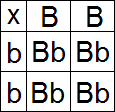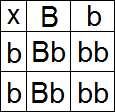When you look at a rabbit, you can see it's dominant genes. You can't tell what recessive genes it has because they do not appear. You can however find out what recessive genes your rabbit carries by doing test matings and looking at the parents information. If you look at a black rabbit, you can see it is black (Or has the B gene). If one of it's parents is brown, your rabbit will carry the chocolate gene, but you can not see this just by looking at the rabbit.
Writing genetics is sometimes a bit confusing. The codes are written in pairs so a black rabbit would have the genes BB unless it carried brown, in which case they would be Bb. A brown rabbit would be bb. Once you learn what letters stand for which colours/patterns it's a lot easier to understand. Remember, the dominant gene(s) always go before the recessive. If you had a black rabbit that carried brown, you would put Bb, not bB because black (B) is dominant over brown (b).
Here is a punnet square and here is what happens when you breed two rabbits...
The top row (BB) can be the male or females genes, although the correct way to write them would be with the buck (male) on the top row, and the doe (female) on the left but if you get them the wrong way around the results will be the same. The first collum (bb) will be the genes of the opposite sex. So, like the punnet square shows, when you breed a black (BB) rabbit to a brown (bb) rabbit, you will get all Black rabbits that carry brown (Bb) because you're putting the B and b together.
Here is another punnet square...
The top row is a rabbit that is black but carries brown (Bb). The first collum is a rabbit that is brown (bb). Some of the babies will be black that carry brown (Bb) and some will be brown (bb).
I would also like to point out, that if a rabbit had the BB (black) gene, it does not mean the rabbit has to be a solid black colour. If the rabbit also had the dilute gene, the rabbit would be blue not black (blue is the dilute of black). There are lots of genes that come together to make a rabbit look the way it does. Don't worry about this too much at the moment, as I was using the B/b gene as an example.
If you understand this I can move on to the actual colours, patterns and markings





